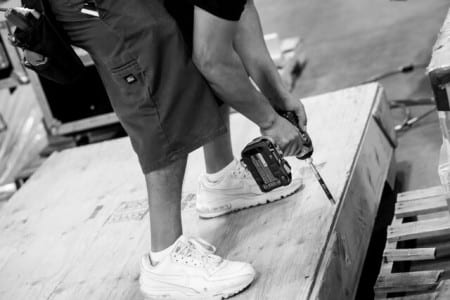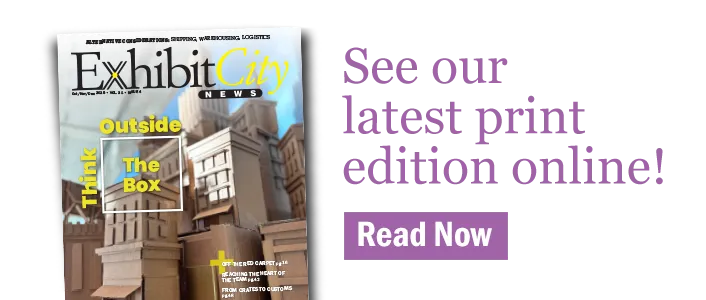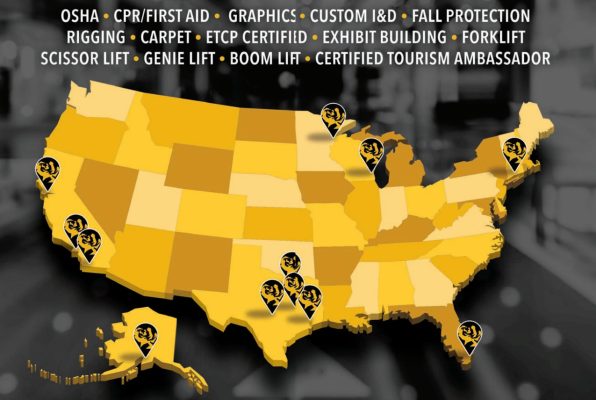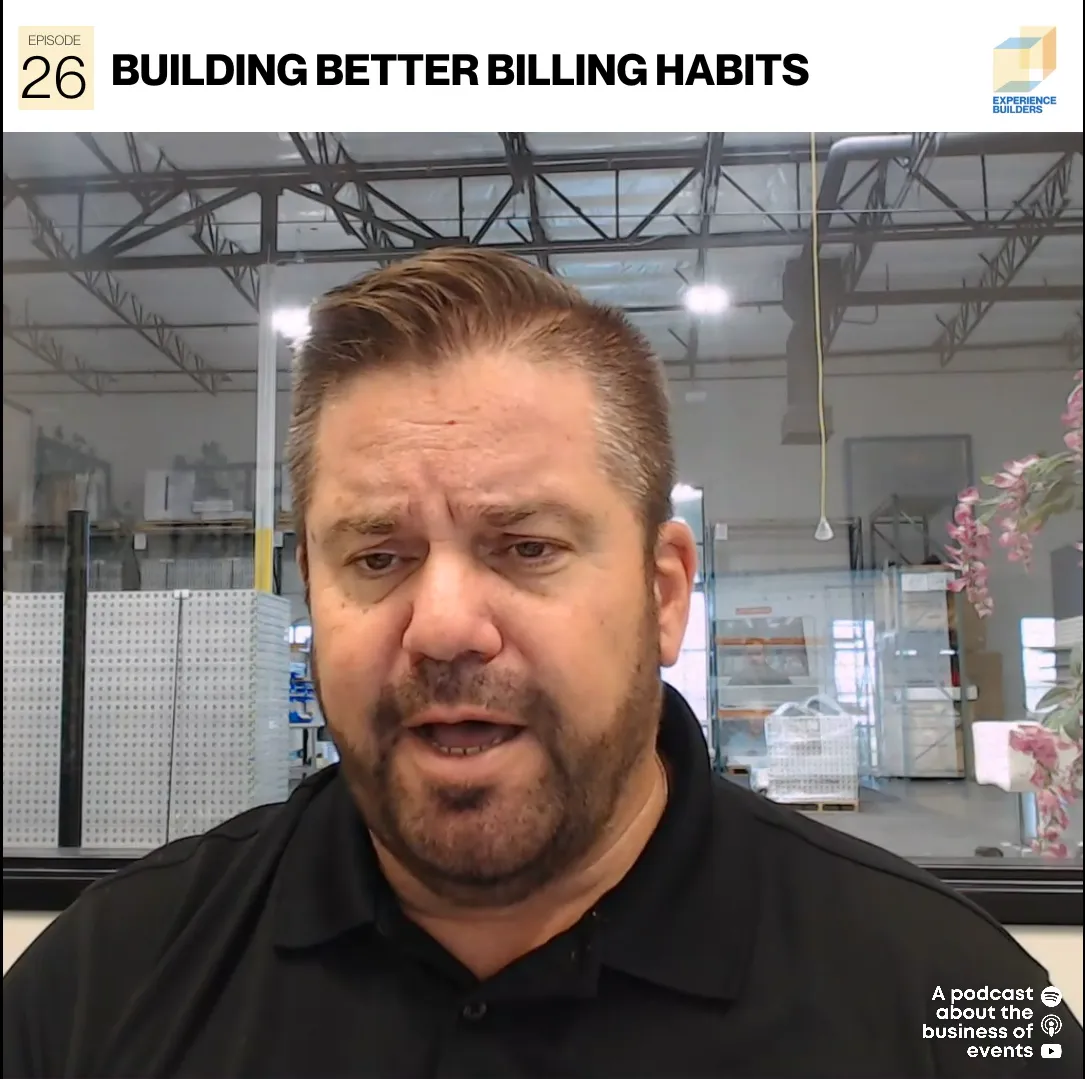Big Budgets, Big Demands
In the 1980s, convention centers were in existence across the country, tradeshows had grown, and it seemed that there would be enough work for everyone. Under Reagan’s presidency, corporations had big budgets, low taxes and minimum documentation requirements, leading to the rise of large exhibits and increasing demands.

Joe Toback, president of Local 510 Sign & Display in San Francisco, remembers an instance when, after a labor crew spent three days hanging streamers across a ceiling, the exhibitor decided to change the color of the streamers and the work had to be redone. Another time, a businessman was willing to pay the labor crew to paint a ceiling three football fields long from grey to white, then repaint it to grey once the show closed. He was denied the request only because there was not enough time before the event for the paint to dry.
There was a feeling of invincibility at this time. The thought was that marketing in this form would always be needed because there have been marketplaces where people gather to trade goods and services for as long as businesses have existed. Even during a recession, competition drove businesses to tradeshows, and some tradeshows grew. The labor crews benefitted from the steady work and occasional bonuses, such as when a business would add four hours of time to every guy’s paycheck for a job well-done.
Demand for Lightweight Exhibits
Into the next decade, tradeshows were finding their constraints. Businesses had new taxes and documentation requirements that made them accountable for their spending. At the same time, the cost of fuel was rising, which meant that fewer people were traveling to tradeshows and heavy wooden exhibits packed in huge crates were more expensive to ship.
Then digital textile printing was invented, a technology that revolutionized tradeshow exhibit design. In 1992, Skyline Exhibits was the first exhibit producer to sell these printing services, offering more creative possibilities for lightweight exhibits.
Adding Tech Tools to Tool Belts
The tech industry boomed in the late 1990s, changing shows like COMDEX, which was born from a small gathering in 1979 for computer dealers to preview new offerings, into mega-shows with exhibitors like IBM, Sun Microsystems, Microsoft and HP. COMDEX drew an attendance of approximately 220,000 in 1997. Other large tech shows included MacWorld, Interop, Networld, PC Expo, Consumer Electronics Show (CES), Internet World and E3.
Although the personal computer was becoming rapidly accessible, technology was not sleek and sexy like it is today. This was a time before flat screen monitors, portable laptops and iPads. Computers brought to show site were towers accompanied by huge monitors and keyboards, and installation crews were given the challenge of installing gigantic and heavy TVs inside exhibit structures.
Large crews were needed to set-up these tradeshows. When Freeman was designated the official service contractor for the COMDEX Fall 2000 show, they were given three months to prepare the 1 million square-foot exhibit hall. Production involved 11 account executives, two dedicated designers, 145 supervisors and labor calls in excess of 1,600 union workers. The show hosted more than 200,000 attendees.
These tech companies were leading the world in innovation, and they were the exhibitors who expected more from their labor service providers. Exhibits were large, incorporating new technology that not even the average consumer had access to. Installers had to step up and add tech tools to their tool belts. Now I&D companies needed MacGyver-type workers who are not only good at carpentry, but also had the ability and willingness to learn new technology.
“If we don’t have tech tools, the tools in our tool belt aren’t important. Our customers expect that of us,” said Scott Bennett, executive vice president of Nth Degree in 2012. “Early on, in the days of Comdex and all the big tech shows, we were scolded by many of our technology customers and told that if we couldn’t keep up with them, we would have a hard time dealing with them. So we stepped up. There’s no going back.”

Housing to the Show Floor and More Services for Medical Industries
In the late 1990s, the housing market was booming and attendees were flocking to shows like International Housewares, Kitchen & Bath, the Builders Show and PCBC. Showing everything from bathroom fixtures and vacuum cleaners to siding and decorative rocks, installing these exhibits was like building a house in a few days. The labor market for these shows was highly competitive, but there was so much work to be done that there still seemed to be work for everyone.
Medical meetings were also being held in very desirable locations across the country. Elaborate exhibits that needed to be constantly stocked with literature and giveaways meant that labor continued after set-up and right on through to teardown.
A Blow to the Industry
In the early years of the new millennium, there were signs that the dotcoms were crashing. The tech start-ups weren’t delivering on their promises and venture capital was drying up. Attendance was declining at tech shows, leading to the closure of Internet World and the merging of Interop and Networld.
Then the unthinkable happened. While large numbers of people were in Atlanta for Networld-Interop on its opening day, Sept. 11, 2001, the U.S. was attacked. When exhibitors and attendees in Atlanta heard the news, they were desperate to get home to their families and the show closed at 2 p.m. The sheer terror that hit everyone was augmented by the fact that suddenly there was no air travel and those traveling couldn’t get home to loved ones.
And as swiftly as the planes flew into the World Trade Center, the prideful tradeshow industry was brought to its knees. People were terrified to travel, especially to major cities that were at risk for another attack. Many shows scheduled for September, the traditional opening of the corporate tradeshow season, were cancelled, and labor crews were suddenly out of work. The fallout from 9/11 hit the industry across the board: suppliers, exhibitors, attendees and all of their families.
One year after 9/11, Rebecca Leib, writing in ClickZ about Internet World could say: “This week, I visited Internet World Fall 2002. The once monolithic, must-attend, see-and-be-seen extravaganza has fizzled into a nonevent, astonishing only to the degree it has lost any ability to astonish. As recently as two years ago, attending Internet World at New York’s cavernous Javits Center was atmospherically akin to spending New Year’s Eve a few blocks across town in Times Square (but heavier on Dockers and PDAs). The atmosphere was frantic and very, very, very crowded. Exhibitor booths studded every nook and cranny of the space, even spilling into a specially erected tent outside. A crush of people jostled to get near (much less through) the door. Yesterday, you could all but see tumbleweeds blowing through the vast, near-empty hall. It took seconds to clock everyone I knew there. Sightlines were that good.”
Slow Recovery
In 2003, Skip Cox, CEO, Exhibit Surveys, reported that events external to the industry – the economy, the 9/11 fallout and market place forces – were exacerbated by internal industry forces. Exhibit budgets continued to come under fire, attendance was down and the perception was that the ROI was non-commensurate with the money spent. The general business environment was negatively impacting the use, relevancy and value of many exhibitions to both attendees and exhibitors. The quick fix to meet earnings projections on Wall Street was to funnel money from budgets like travel, tradeshows, advertising and the like to the bottom line.
There was tremendous downsizing after 9/11. Middle managers, the group that has historically been most involved in exhibiting, were losing their jobs, which meant fewer people were going to shows. The mergers, acquisitions and attritions meant there were fewer exhibitors. Smaller companies went out of business, and the large companies saw less need to attend shows.
For industry suppliers, particularly labor companies, there were additional problems. Exhibit houses, and in many instances, labor company customers, were forced out of business. In some cases, only their ‘assets’ were acquired by larger companies, leaving many labor companies unable to collect debts from the acquired exhibit houses. The EACs soon realized that they had to provide a point of differentiation if they were to survive.
The Great Recession
Just as the tradeshow industry began to recover, the U.S. was hit with the banking crisis, which shook the already weak economy. Practices of some of the banks came to light, and the press was filled with stories of executives’ extravagant spending at meetings and tradeshows. Under scrutiny from every legislative body, tradeshows were labeled as boondoggles and opportunities for excesses and kickbacks.
During this time, the credit crisis had a profound effect on both personal and professional lives. Many of the companies in the industry are small suppliers, and any threat to the wellbeing of the owner usually became a threat to the wellbeing of the company and its employees.
As the economy was making a slow comeback in 2012, the tradeshow industry was still feeling the aftershock. Because of all the press attention on kick-backs, industries such as health care downplayed any hint of extravagance. Giveaways at health care shows became almost non-existent, and sales reps could no longer take the opportunities that tradeshows presented to take their doctors to lunch or dinner.
One of the major differences that all this has made to tradeshow labor companies is that exhibitors are controlling costs now by choosing smaller, lighter exhibits that make lavish use of metal systems and fabric. Knowing how to use these systems and install fabric requires a new skill set, different from the days of hard wall construction. We will explore the new trends throughout this series.





















